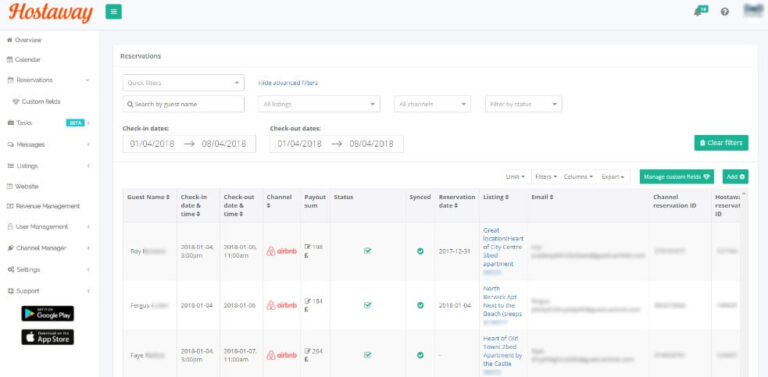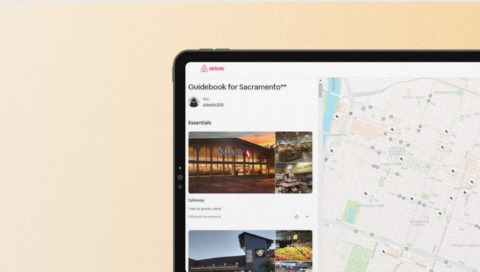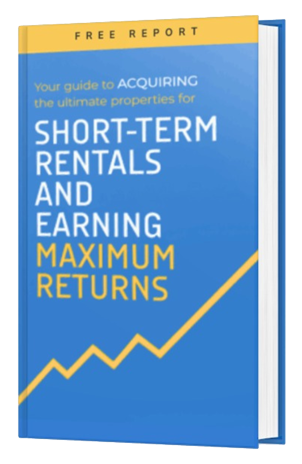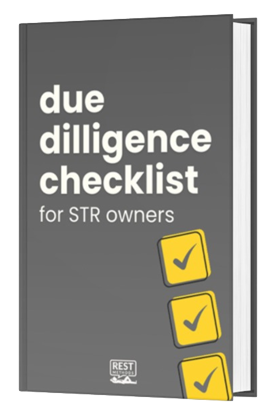Ever wondered how to skyrocket your occupancy rates and offer more to your guests? That’s exactly where an Airbnb linked listing comes in. A strategy that’s changing the game for hosts worldwide.
This comprehensive guide will walk you through every aspect, from understanding the concept to managing your listings effectively.
Understanding the Concept
This innovative concept, referred to as a combined listing or Airbnb linked listing, is rooted in the principle of maximizing the utility of your property, ensuring that every available space is optimized to enhance your rental income.
It’s important to note that while we refer to it as an Airbnb linked listing, this concept can be applied across various booking channels, not just Airbnb.
The inception of an Airbnb linked listing is a response to the diverse and evolving needs of travelers. Guests seek a variety of accommodation options, from cozy single rooms to expansive family homes.
In essence, a linked listing involves two separate properties, each with its own individual listing, plus a third listing that combines the two. This way, when a guest goes to book, they see everything in one listing, providing them with a comprehensive view of all available options.
An Airbnb linked listing allows hosts to cater to this diverse demand by offering multiple, flexible listing options from a single property. This approach not only broadens the scope of potential guests but also ensures that hosts can make the most of their property.
The Benefits of an Airbnb Linked Listing
Delving into the mechanics, Airbnb linked listing enables you to list different units of a single property separately or as a combined listing.
Consider a property with a main house and a guest house in the backyard. Traditionally, you might list them separately, limiting the options for larger groups or families who wish to book both.
With a linked listing, you can create a joint listing for the entire property, offering more space and amenities to potential guests. This strategy enhances the appeal of your listing, attracting a wider guest demographic and boosting your booking rates.
| Regular Airbnb Listings | Airbnb Linked Listings | |
|---|---|---|
| Listing type | Single unit or property listed. | Multiple units within a single property, either listed separately or combined. |
| Target audience | Typically solo travelers, couples, or families looking for a specific type of accommodation. | Diverse range, from solo travelers to large groups, offering flexibility in accommodation choices. |
| Occupancy potential | Limited to the capacity of the single listed unit. | Higher, as hosts can accommodate guests in separate units or a combined larger space. |
| Management complexity | Relatively simpler, managing one listing at a time. | Requires careful management to ensure no overlaps in bookings between individual and combined listings. |
| Pricing strategy | Fixed or dynamic pricing based on demand, seasonality, local events, etc. | Dynamic pricing can be applied, with added flexibility for combined accommodations or additional charges for larger groups. |
| Visibility on Airbnb | One listing equals one visibility spot on Airbnb. | Multiple listings from one property can increase visibility on the platform. |
| Revenue potential | Revenue is based on the occupancy of the single unit. | Potential for increased revenue by renting out multiple units or combined spaces. |
| Flexibility for hosts | Limited flexibility in terms of space utilization. | Greater flexibility in offering varied accommodation options and maximizing space utilization. |
| Risk of overbooking | Low, as there’s only one listing to manage. | Managed efficiently by Airbnb’s system, which blocks other linked listings when one is booked. Using a property management software makes all this much easier. |
The Linked Listing in Action
Let’s visualize the Airbnb linked listing in action.
Think of a scenario where a family is planning a reunion. They require multiple rooms and spaces to accommodate all members comfortably. Your property, with its main and guest house, emerges as the perfect fit for their needs when listed together.
On the flip side, consider a solo traveler seeking a quaint and private space for a weekend getaway. Your guest house, listed separately, fits the bill perfectly. This flexibility is the cornerstone of the Airbnb linked listing, ensuring that your property is accessible and appealing to a broad spectrum of travelers.
The Impact on Occupancy and Revenue
The impact of Airbnb linked listing on occupancy and revenue is profound. By offering varied and flexible listing options, you enhance the visibility and attractiveness of your property on the Airbnb platform.
This increased exposure translates to higher booking rates, ensuring that your property is consistently generating income.
Additionally, the ability to accommodate larger groups by listing multiple units together allows you to charge higher rates, further augmenting your rental income.
Navigating the Challenges
While the concept of Airbnb linked listing is compelling, it’s essential to navigate it with insight and strategy. Effective management of multiple listings, ensuring availability, and providing a seamless booking and stay experience for guests are paramount.
Utilizing Airbnb’s robust platform features, such as synchronized calendars and automated booking management, can aid in efficiently managing your Airbnb linked listing, ensuring it operates smoothly and continues to be a lucrative venture.

Don’t let poor management crush your returns.
Follow my 3-step mandatory reservation checklist to ensure your property is prepared to maximize returns.
Setting Up an Airbnb Linked Listing
Setting up an Airbnb linked listing is a straightforward process.
Create separate listings for each unit and a joint listing that combines them. Airbnb’s system is designed to manage such listings efficiently, blocking other listings when one is booked to avoid overbooking.
Managing Airbnb Linked Listings
Effective management is crucial for the success of your Airbnb linked listing. Utilize property management software platforms to ensure your calendars are synced, and bookings are managed seamlessly.
This strategy helps in avoiding overbooking and ensuring a smooth operation.
To streamline this, we use Hostaway, a property management software. With Hostaway, all calendars across different listings are synchronized, ensuring real-time updates and minimizing overbooking risks. It consolidates all guest communications into a unified inbox, making interactions more efficient.

Plus, its automated workflows handle tasks like booking confirmations and check-in reminders, while its analytics provide insights into each listing’s performance.
Pricing and Additional Charges
Pricing your linked listing strategically is essential. Consider applying additional charges for extra guests to manage larger groups effectively.
This approach not only deters overly large groups but also ensures you are compensated fairly for accommodating more guests. Let’s take a look at some examples to get a clearer picture.
Base pricing
Start with a base price for the main property or the primary configuration of your listing. This price should cover your basic expenses, desired profit margin, and be competitive within your local market.
e.g. If you have a main house that comfortably sleeps four guests, set a base price of $150 per night.
Seasonal adjustments
Linked listings can be especially appealing during peak seasons when larger groups are looking for accommodations. Adjust your prices to reflect the increased demand during these periods.
If the combined listing you have is a 4 bedroom unit plus a 3 bedroom unit, one of them might be really high in season all year long, while the other not so much. This would be a great way to take advantage of higher seasonal rates when the larger unit is needed. On the other hand when it’s low season, the occupancy is still going to stay higher because you have two different options.
e.g. If summer is a peak season in your area, consider raising the base price to $180.
Handling Larger Groups

When it comes to larger groups, the dynamics of hosting change considerably. The wear and tear on your property can be more significant, the noise levels might increase, and the overall requirements from the guests can be more demanding.
1. By implementing a buffer between the time a guest makes a reservation and their actual check-in date, you gain more control over the reservation process.
For instance, by not allowing same-day check-ins, you provide yourself with ample time to prepare for your guests, especially larger groups with specific needs. This proactive approach ensures that you can anticipate and cater to the requirements of your guests, ultimately enhancing their experience and satisfaction.
2. Keeping a day or two gap between check-outs and check-ins can be beneficial.
This buffer allows for thorough cleaning, maintenance checks, and any required repairs, ensuring your property is in top condition for the next group.
For example, if a group of 10 checks out on a Sunday, block Monday for cleaning and maintenance, and allow the next check-in on Tuesday.
3. Before confirming a booking for a larger group, communicate with the guests.
Understand the purpose of their stay, any special requirements they might have, and set clear house rules. This ensures that the group is a good fit for your property and sets clear expectations.
If a group of 12 wants to book your property for a reunion, discuss any events they plan to host, their schedule, and any additional services they might require.
Challenges and Solutions
Every strategy, no matter how effective, comes with its set of challenges. Airbnb linked listings are no exception. However, with a proactive approach, these challenges can be turned into opportunities.
1. Overlapping bookings
One of the common challenges with linked listings is the potential for overlapping bookings. This can be avoided with effective calendar management and clear communication with guests.
Use property management software (like the one we mentioned before – Hostaway) or Airbnb’s in-built tools to sync calendars and avoid double bookings. Also, clearly mention in your listing description the configurations available to avoid confusion.
2. Operations Coordination for Varied Property Sizes
When managing properties of different sizes, it’s crucial to ensure that our housekeeping and operations teams are in sync, especially when guests book sections of a property or opt to combine units.
Clear communication is key to guarantee that our team understands the various booking configurations possible and the corresponding preparation needed for each scenario.
This alignment is essential not only for housekeeping but also for ensuring that we are all on the same page regarding pricing, amenities, and other essential details that can vary depending on whether a guest has booked a portion of the property or the entire space.
Regular team meetings and clear documentation can help facilitate this understanding and ensure a smooth operation.
3. Guest Avatar Adaptation
Your guest avatar can significantly vary based on the size of the property they choose to book.
For instance, if a guest opts for your linked listing, which combines multiple units to create a larger space, it’s crucial to understand the specific needs and expectations of this guest avatar.
They might be a larger family or a group of friends seeking a communal experience, and their requirements will differ significantly from those booking a single, smaller unit.
By recognizing and adapting to the unique needs of each guest avatar, you can ensure that you meet their expectations and provide a tailored, memorable experience. This includes not only the physical amenities and space but also the information and local recommendations you provide to enhance their stay.
Final thoughts
An Airbnb linked listing is a transformative strategy for hosts looking to maximize their occupancy and revenue. By understanding the concept, effectively setting up and managing your listings, and overcoming challenges, you can unlock the full potential of Airbnb linked listing for your property.
By following this comprehensive guide, you equip yourself with the knowledge and strategies needed to effectively manage and optimize your Airbnb linked listing for maximum benefits. The world of short-term rentals is full of opportunities, and with an Airbnb linked listing, you are one step closer to unlocking them.









